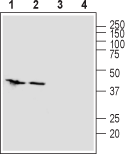Overview
- Peptide (C)GEPELLVWRPEAVASE, corresponding to amino acid residues 5-20 of human ZIP1 (Accession Q9NY26). Extracellular, N-terminus.

 Western blot analysis of rat (lanes 1 and 3) and mouse (lanes 2 and 4) brain lysates:1,2. Anti-ZIP1 (SLC39A1) (extracellular) Antibody (#AZT-001), (1:200).
Western blot analysis of rat (lanes 1 and 3) and mouse (lanes 2 and 4) brain lysates:1,2. Anti-ZIP1 (SLC39A1) (extracellular) Antibody (#AZT-001), (1:200).
3,4. Anti-ZIP1 (SLC39A1) (extracellular) Antibody, preincubated with ZIP1/SLC39A1 (extracellular) Blocking Peptide (#BLP-ZT001). Western blot analysis of human U-87 MG glioblastoma cell lysate (lanes 1 and 3) and human MDA-231 breast adenocarcinoma cell lysate (lanes 2 and 4):1,2. Anti-ZIP1 (SLC39A1) (extracellular) Antibody (#AZT-001), (1:200).
Western blot analysis of human U-87 MG glioblastoma cell lysate (lanes 1 and 3) and human MDA-231 breast adenocarcinoma cell lysate (lanes 2 and 4):1,2. Anti-ZIP1 (SLC39A1) (extracellular) Antibody (#AZT-001), (1:200).
3,4. Anti-ZIP1 (SLC39A1) (extracellular) Antibody, preincubated with ZIP1/SLC39A1 (extracellular) Blocking Peptide (#BLP-ZT001).
 Expression of ZIP1 in rat hippocampusImmunohistochemical staining of perfusion-fixed frozen rat brain sections using Anti-ZIP1 (SLC39A1) (extracellular) Antibody (#AZT-001), (1:400), followed by anti-rabbit-Alexa-488 antibody. ZIP1 is expressed (green) in the mossy fiber (MF) terminal field (arrows) of the CA3 hippocampal region. Nuclei are labeled with DAPI (blue).
Expression of ZIP1 in rat hippocampusImmunohistochemical staining of perfusion-fixed frozen rat brain sections using Anti-ZIP1 (SLC39A1) (extracellular) Antibody (#AZT-001), (1:400), followed by anti-rabbit-Alexa-488 antibody. ZIP1 is expressed (green) in the mossy fiber (MF) terminal field (arrows) of the CA3 hippocampal region. Nuclei are labeled with DAPI (blue).
- Jeong, J. and Eide, D.J. (2013) Mol. Aspects Med. 34, 612.
- Franklin, R.B. and Costello, L.C. (2007) Arch. Biochem. Biophys. 463, 211.
- Jiang, Y. et al. (2014) PLoS One 9, e116043.
Zinc uptake transporter, ZIP1, belongs to the SLC39 transporter family. This transport has the ability to increase zinc concentration when cellular zinc level is low, by active zinc transport into the cytoplasm from extracellular space of the cell or the intracellular storage compartment. Thus, zinc transport plays a crucial role in regulating cellular zinc homeostasis1-3.
Regulation and maintenance of proper concentration and distribution of cellular zinc are essential to the function, metabolism, growth, proliferation and survival of cells. Zinc deficiency can cause defects in the immune system, including abnormalities in T-cells, natural killer cells and monocytes, and reduction in antibody formation1,2.
In the human genome, 20 ZIP transporters have been identified. ZIP1 is encoded by the SLC39A1 gene3.
ZIP proteins are highly conserved. Members have eight predicted transmembrane (TM) domains with extracellular N- and C-termini. There is a long loop region harboring a histidine-rich domain between TM3 and TM4. Zinc uptake by ZIP1 is energy independent2.
ZIP1 is ubiquitously expressed in human tissues including blood, brain, gill, heart, intestine, liver, muscle, skin, spleen and kidney3.
Accumulation of zinc in prostate cells by ZIP1 inhibits their growth and proliferation. Therefore, ZIP1 is associated as a tumor suppressor gene in prostate cancer2.
Application key:
Species reactivity key:
Alomone Labs is pleased to offer a highly specific antibody directed against an epitope of the human Zinc transporter ZIP1. Anti-ZIP1 (SLC39A1) (extracellular) Antibody (#AZT-001) can be used in western blot and immunohistochemistry applications. The antibody recognizes an extracellular epitope and is thus ideal for detecting the protein in living cells. It has been designed to recognize ZIP1 from mouse, rat and human samples.

